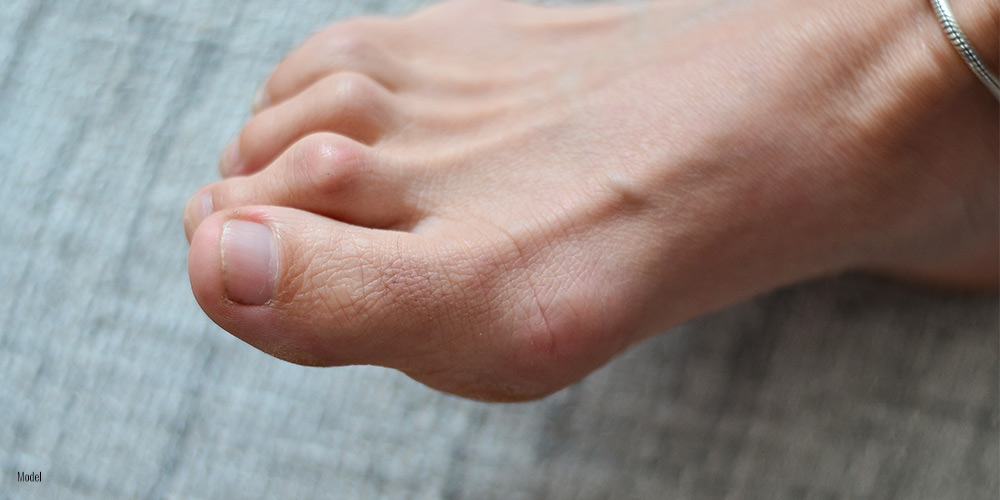Minimal Incision Hammertoe Surgery in NYC
Posted November 08, 2024 in Hammertoes

This blog discusses different types of minimally invasive hammertoe surgeries, the pros and cons of hammertoe surgery, preventative options, and probable causes of hammertoe.
4 Min Read:
How to Treat Hammertoe
Most people don’t pay attention to their feet until something goes wrong. A hammertoe is a very common condition, but many people don’t know what causes it or how to fix it. If you think you have a hammertoe, you have some options for treatment that don’t involve invasive surgery or long recovery periods.
What Minimally Invasive Hammertoe Surgery Options Are There?
Minimally invasive surgery means your surgeon is using techniques that do not cause undue trauma to the treatment area, often resulting in faster recovery and less downtime. The following options are used to treat hammertoes:
Joint Resection (Arthroplasty)
During this procedure, the surgeon makes a small incision on the top or the side of the affected toe, where it is bent at the joint. This incision releases constructed ligaments and tendons that cause the toe to curl. They straighten the toe and tendons, then remove a small portion of the bone so that when healed, it will rest normally. Sometimes, a surgical pin is necessary to keep the toe from moving, but this is removed after a few weeks.
Fusion (Arthrodesis)
Fusion surgery begins with a joint resection to flatten and straighten the bones. Then, the ends of the bones in the toes are removed to allow them to heal together, which is called fusion. This is achieved either with the use of a pin (which is later removed) or with the use of an implant that fuses the two bones together.
What Are the Pros and Cons of Hammertoe Correction?
Pros:
- Hammertoe surgery does offer minimally invasive options that are successful, meaning more invasive methods are not necessary.
- Leaving advanced hammertoe deformities untreated can result in limited mobility and debilitating pain.
- Hammertoe surgery has a relatively high success rate.
Cons:
- Although these methods are less invasive, they do require some recovery care and downtime.
- There is a small risk that your hammertoes will come back, even after surgery.
What Hammertoe Option Is Best For Me?
Podiatrists usually determine the best course of action for hammertoe treatment based on the severity of your case. For example, if you still have pretty good flexibility in the joint, there’s a good possibility that your condition can improve without the need for surgery. In this case, they may suggest one of the following conservative options:
- Shoe inserts to reposition pressure from the toes
- Orthopedic straps to flatten the toe
- OTC medications for pain
- Corticosteroid injections for pain
For patients with more severe cases, surgery is usually the best option. Leaving your hammertoe untreated can lead to a loss of mobility, chronic pain, and difficulty walking—and the worse it gets, the harder it is to treat.
What Causes Hammertoe?
It’s different for everyone, and most patients with hammertoe often have a combination of factors influencing their case. Here are some possible causes of hammertoe:
- Tight or constrictive shoes. Shoes with narrow toes or high heels that place pressure on the toes constrict the bones and muscles so they don’t lie flat. With regular wear, this can cause the toes to remain curled, even when not wearing shoes.
- Trauma or injury. Sometimes, toes that have been stubbed or broken may not heal properly, causing them to develop hammertoe.
- Imbalance of the toe muscles. Weakened or imbalanced toe muscles can put pressure on the tendons and joints, restricting them and resulting in hammertoe.
Can I Prevent Hammertoe?
In some cases, yes! It’s important to wear proper footwear whenever possible, shoes that support your arches but also leave enough space in the toe for your toes to remain flexible. You should be able to spread your toes inside your shoes.
If you prefer a high heel style, try incorporating a lower heel so that your center of gravity is more moderate and does not rest completely on your toes.
Learn More About Minimally Invasive Hammertoe Surgery in NYC
At Chelsea Foot & Ankle, we aim to treat common foot ailments like hammertoe with conservative treatments whenever possible. We want our patients back on their feet as soon as possible, so minimally invasive surgery is our preferred treatment. If you have hammertoe and would like to schedule a consultation with our NYC podiatrists, call us today at (646) 929-4149 or fill out our contact form.
